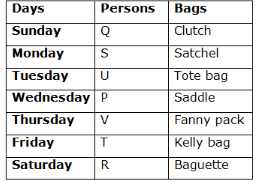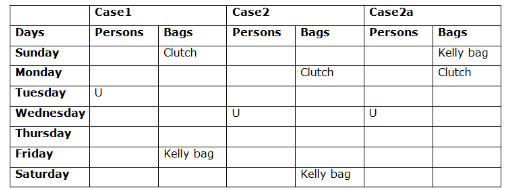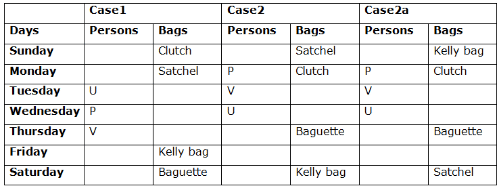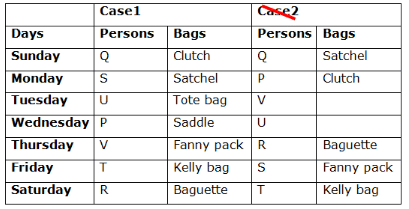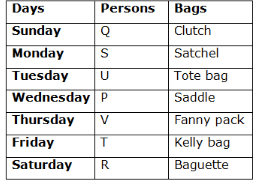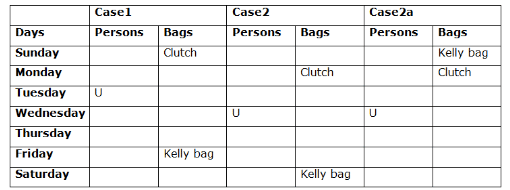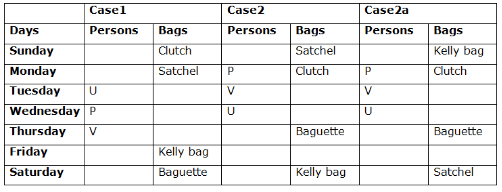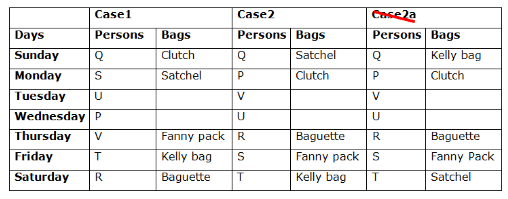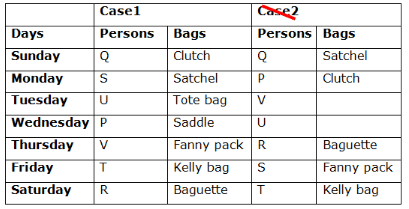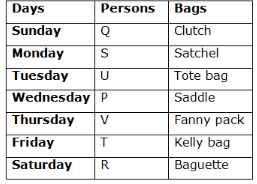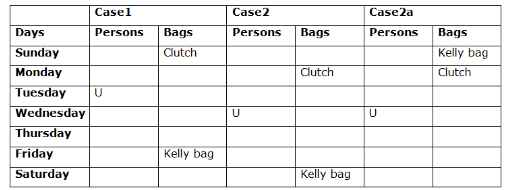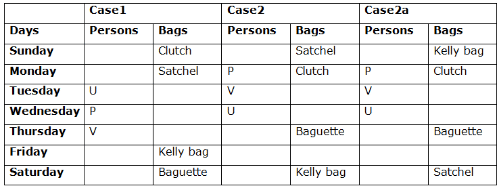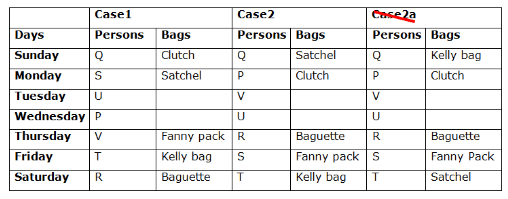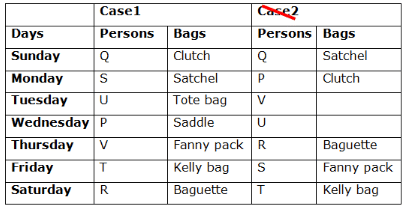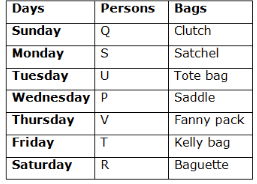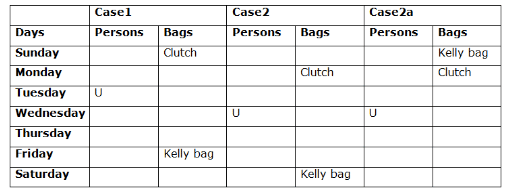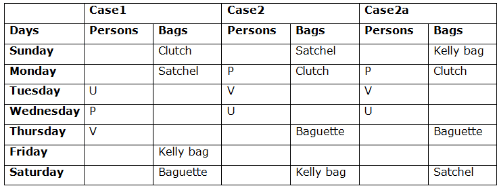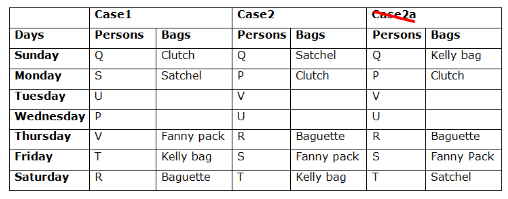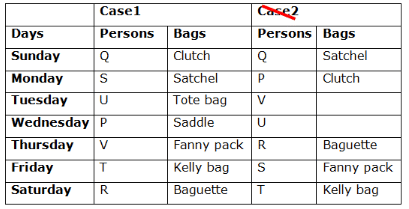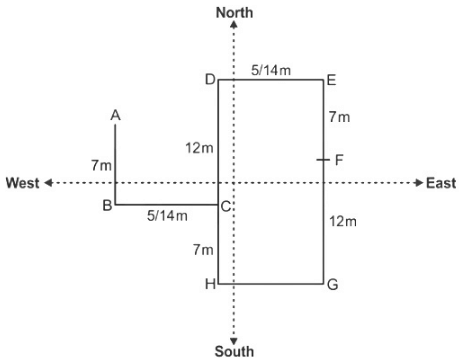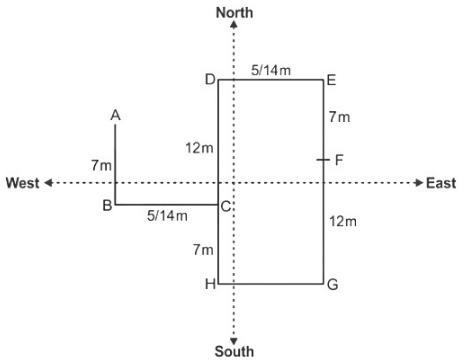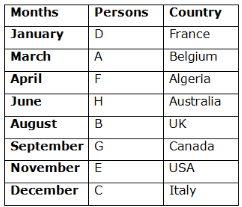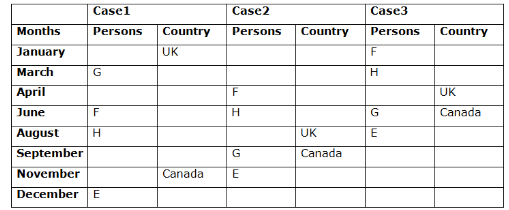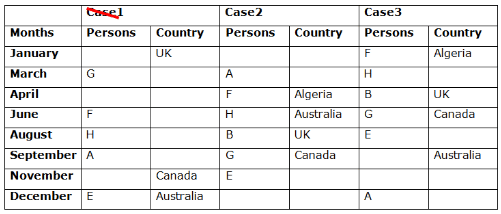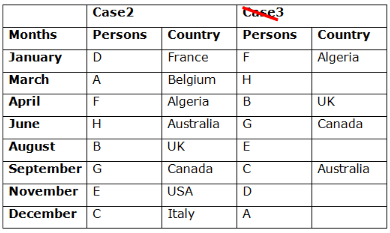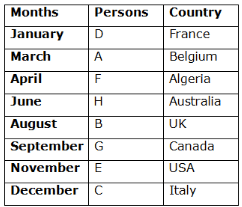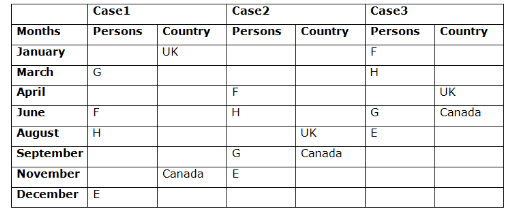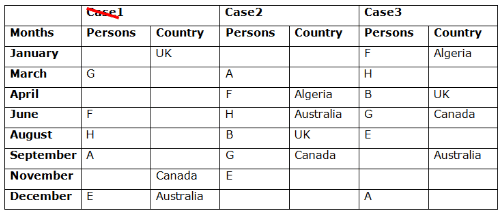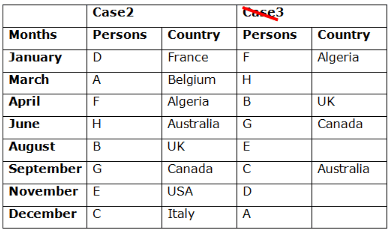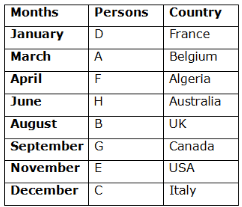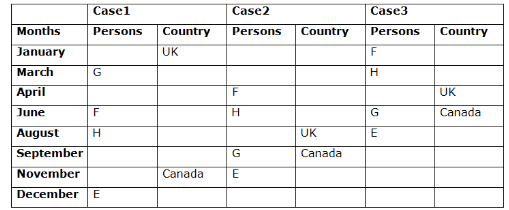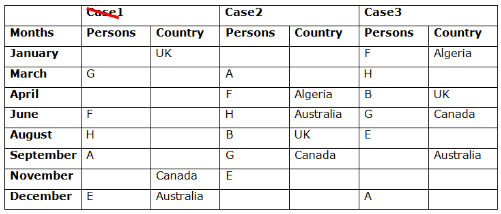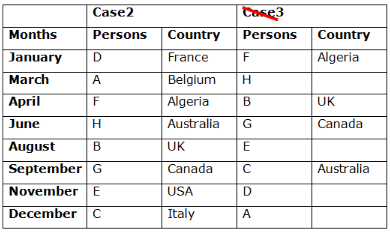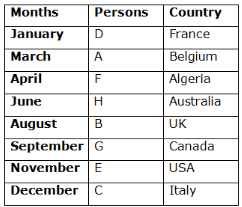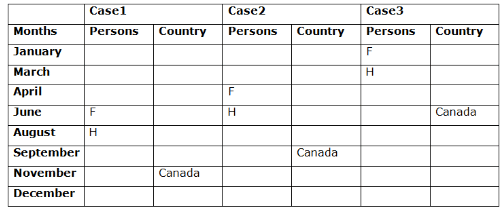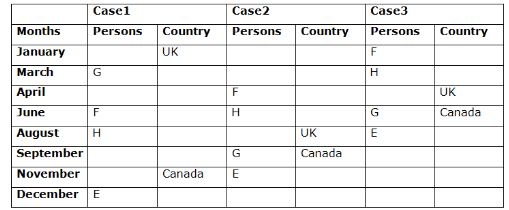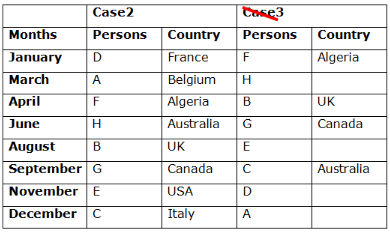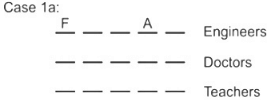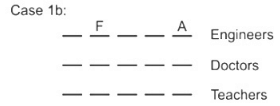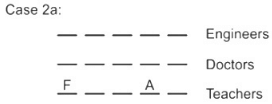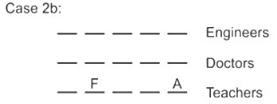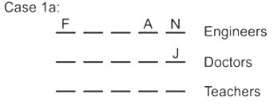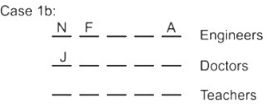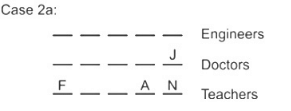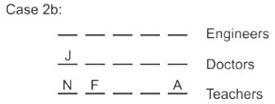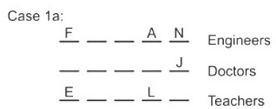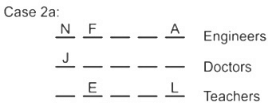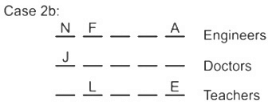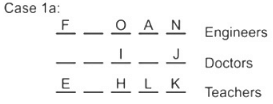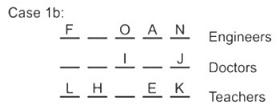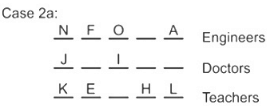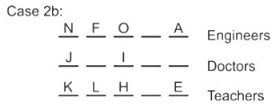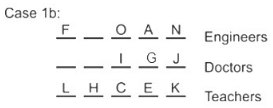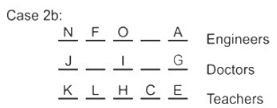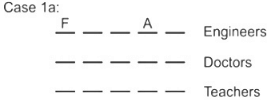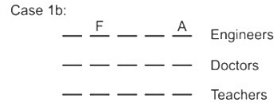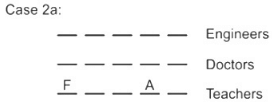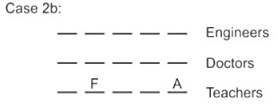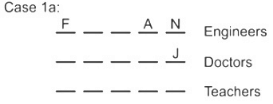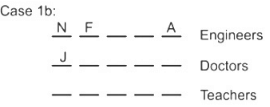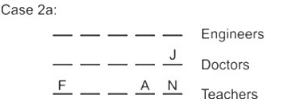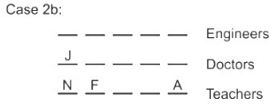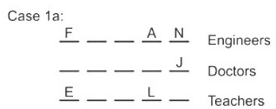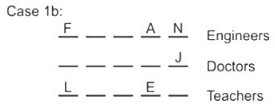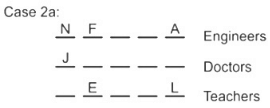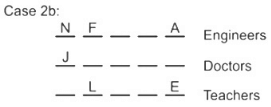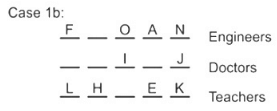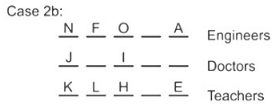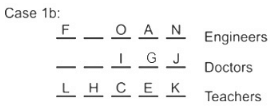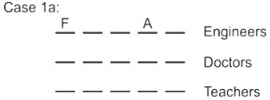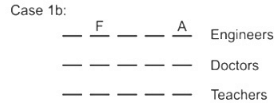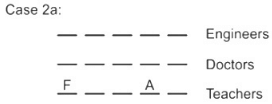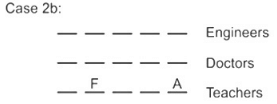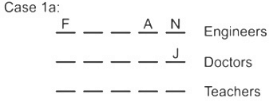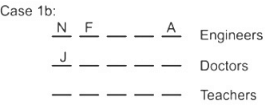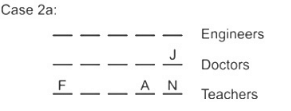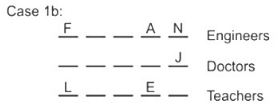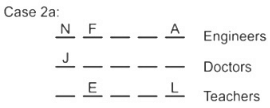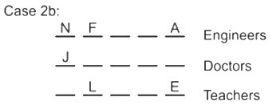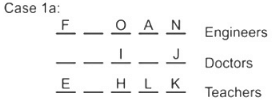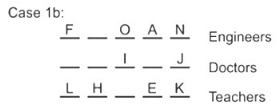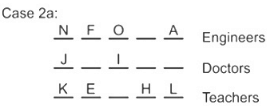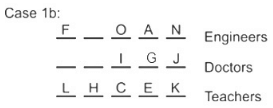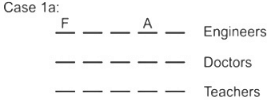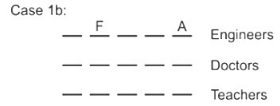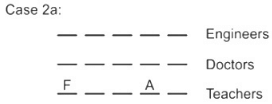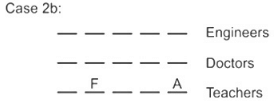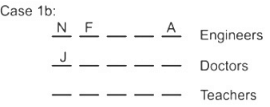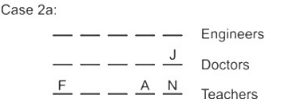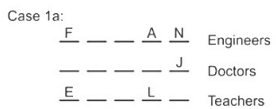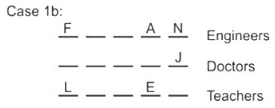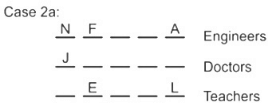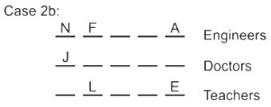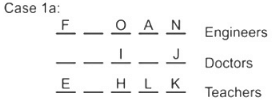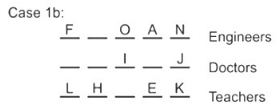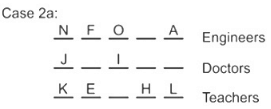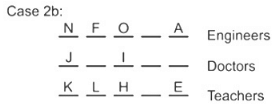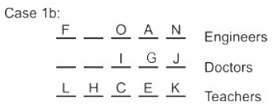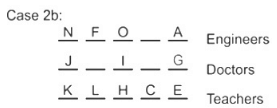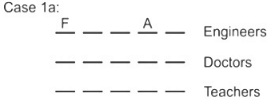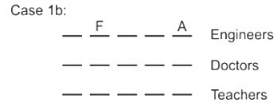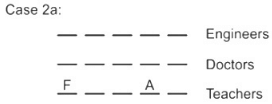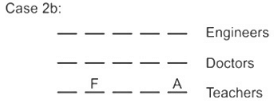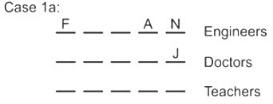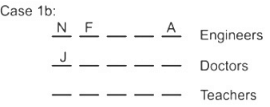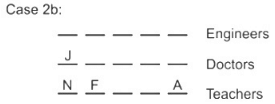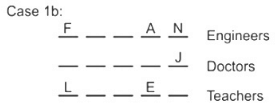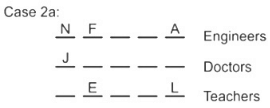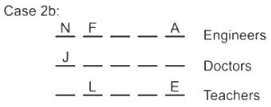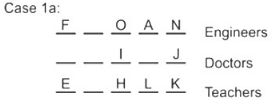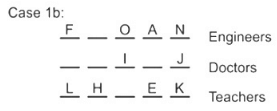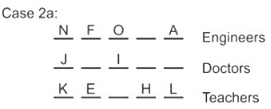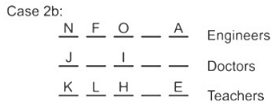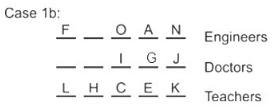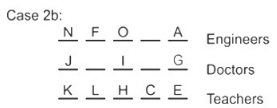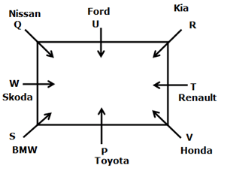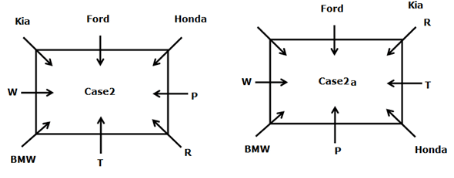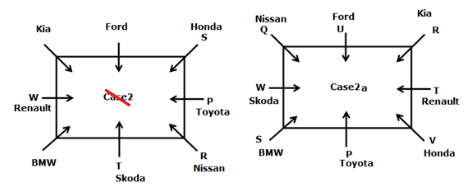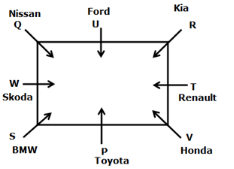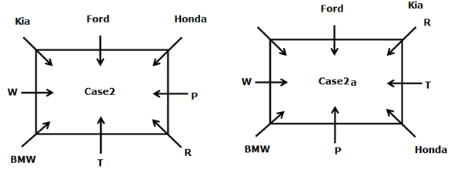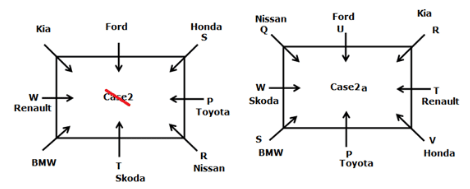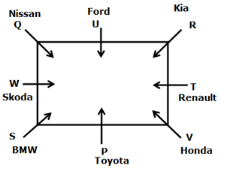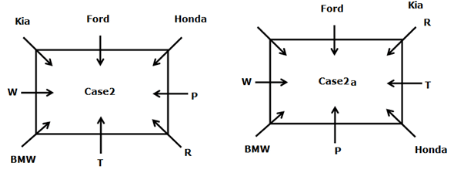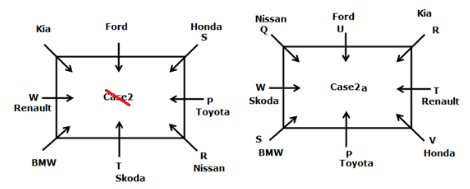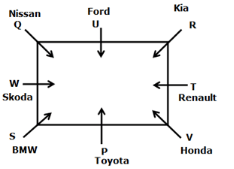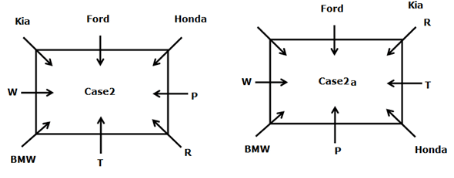RBI Assistant Mains Mock Test - 6 - Bank Exams MCQ
30 Questions MCQ Test - RBI Assistant Mains Mock Test - 6
What will come in the place of question mark(?).
8, 72, 576, 4062, 24192, ?
Study the following information carefully and answer the below questions
Seven persons- P, Q, R, S, T, U, and V are going shopping on different days of the week starting from Sunday to Saturday. They use different types of bags- Fanny bag, Kelly bag, Clutch, Satchel, Tote bag, Saddlebag, and Baguette. All the information is not necessarily in the same order.
The one who uses Clutch goes three days before the one who goes immediately after U. U neither goes on Thursday nor Friday. Only two persons are going between U and the one who uses the Kelly bag. The number of persons goes before the one who uses the Kelly bag is the same as the number of persons goes after the one who uses Satchel. P goes immediately after the one who goes two persons before V. V goes two persons before the one who uses Baguette. T goes immediately after the one who uses a Fanny pack. The number of persons goes between U and S is the same as the number of persons goes between T and the one who uses Baguette. Q neither uses Baguette nor Kelly bag. Neither U nor V uses a Saddlebag.
Who among the following person goes immediately before the one who uses the Fanny bag?
Study the following information carefully and answer the below questions
Seven persons- P, Q, R, S, T, U, and V are going shopping on different days of the week starting from Sunday to Saturday. They use different types of bags- Fanny bag, Kelly bag, Clutch, Satchel, Tote bag, Saddlebag, and Baguette. All the information is not necessarily in the same order.
The one who uses Clutch goes three days before the one who goes immediately after U. U neither goes on Thursday nor Friday. Only two persons are going between U and the one who uses the Kelly bag. The number of persons goes before the one who uses the Kelly bag is the same as the number of persons goes after the one who uses Satchel. P goes immediately after the one who goes two persons before V. V goes two persons before the one who uses Baguette. T goes immediately after the one who uses a Fanny pack. The number of persons goes between U and S is the same as the number of persons goes between T and the one who uses Baguette. Q neither uses Baguette nor Kelly bag. Neither U nor V uses a Saddlebag.
Which of the following bag is used by the one who goes immediately after Q?
Study the following information carefully and answer the below questions
Seven persons- P, Q, R, S, T, U, and V are going shopping on different days of the week starting from Sunday to Saturday. They use different types of bags- Fanny bag, Kelly bag, Clutch, Satchel, Tote bag, Saddlebag, and Baguette. All the information is not necessarily in the same order.
The one who uses Clutch goes three days before the one who goes immediately after U. U neither goes on Thursday nor Friday. Only two persons are going between U and the one who uses the Kelly bag. The number of persons goes before the one who uses the Kelly bag is the same as the number of persons goes after the one who uses Satchel. P goes immediately after the one who goes two persons before V. V goes two persons before the one who uses Baguette. T goes immediately after the one who uses a Fanny pack. The number of persons goes between U and S is the same as the number of persons goes between T and the one who uses Baguette. Q neither uses Baguette nor Kelly bag. Neither U nor V uses a Saddlebag.
Which of the following combination is true?
Study the following information carefully and answer the below questions
Seven persons- P, Q, R, S, T, U, and V are going shopping on different days of the week starting from Sunday to Saturday. They use different types of bags- Fanny bag, Kelly bag, Clutch, Satchel, Tote bag, Saddlebag, and Baguette. All the information is not necessarily in the same order.
The one who uses Clutch goes three days before the one who goes immediately after U. U neither goes on Thursday nor Friday. Only two persons are going between U and the one who uses the Kelly bag. The number of persons goes before the one who uses the Kelly bag is the same as the number of persons goes after the one who uses Satchel. P goes immediately after the one who goes two persons before V. V goes two persons before the one who uses Baguette. T goes immediately after the one who uses a Fanny pack. The number of persons goes between U and S is the same as the number of persons goes between T and the one who uses Baguette. Q neither uses Baguette nor Kelly bag. Neither U nor V uses a Saddlebag.
If all persons are arranged in alphabetical order from Sunday then who among the following person uses the Kelly bag (bags remain the same)?
Direction: Read the following information carefully and answer the given question.
A @ B means A is to the north of B at a distance of either 7 m or 12 m
A # B means A is to the west direction of B at a distance of either 5 m or 14 m
A $ B means A is to the south direction of B at a distance of either 7 m or 12 m
A & B means A is to the east direction of B at a distance of either 5 m or 14 m
A @& B means A is to the north-east of B
A $& B means A is to the south-east direction of B
Statement
A@B, B#C, C$D@&A, D#E@F@&C, F@G$&C, G&H$C
What is the total distance between E and G?
Direction: Read the following information carefully and answer the given question.
A @ B means A is to the north of B at a distance of either 7 m or 12 m
A # B means A is to the west direction of B at a distance of either 5 m or 14 m
A $ B means A is to the south direction of B at a distance of either 7 m or 12 m
A & B means A is to the east direction of B at a distance of either 5 m or 14 m
A @& B means A is to the north-east of B
A $& B means A is to the south-east direction of B
Statement
A@B, B#C, C$D@&A, D#E@F@&C, F@G$&C, G&H$C
In which direction is B with respect to G?
Direction: Read the following information carefully and answer the given question.
A @ B means A is to the north of B at a distance of either 7 m or 12 m
A # B means A is to the west direction of B at a distance of either 5 m or 14 m
A $ B means A is to the south direction of B at a distance of either 7 m or 12 m
A & B means A is to the east direction of B at a distance of either 5 m or 14 m
A @& B means A is to the north-east of B
A $& B means A is to the south-east direction of B
Statement
A@B, B#C, C$D@&A, D#E@F@&C, F@G$&C, G&H$C
If distance between B and C is same as the distance between D and E and this distance is less than the distance between A and B then what is the shortest distance between C and E.
Study the following information carefully and answer the below questions
Eight persons- A, B, C, D, E, F, G, and H like different countries- UK, USA, Italy, Canada, Algeria, Australia, France, Belgium and are visited these countries on different months- January, March, April, June, August, September, November and December of the same year. All the information is not necessarily in the same order. The consecutive alphabetically named persons do not visit adjacent to each other.
H visits two persons before the one who likes Canada who visits in the month which has an even number of days. F visits immediately before H. E visits two persons after the one who visits immediately before the one who likes Canada. The one who likes UK visits immediately before G. G neither visits in November nor December. E does not like the UK. The number of persons visits before the one who likes UK is the same as the number of persons visit after the one who likes Australia. Only one person visits between the one who likes Australia and A. B visits two persons after the one who likes Algeria. The one who likes USA visits immediately before the one who likes Italy. A neither likes Italy nor France.
In which of the following month does B visit?
Study the following information carefully and answer the below questions
Eight persons- A, B, C, D, E, F, G, and H like different countries- UK, USA, Italy, Canada, Algeria, Australia, France, Belgium and are visited these countries on different months- January, March, April, June, August, September, November and December of the same year. All the information is not necessarily in the same order. The consecutive alphabetically named persons do not visit adjacent to each other.
H visits two persons before the one who likes Canada who visits in the month which has an even number of days. F visits immediately before H. E visits two persons after the one who visits immediately before the one who likes Canada. The one who likes UK visits immediately before G. G neither visits in November nor December. E does not like the UK. The number of persons visits before the one who likes UK is the same as the number of persons visit after the one who likes Australia. Only one person visits between the one who likes Australia and A. B visits two persons after the one who likes Algeria. The one who likes USA visits immediately before the one who likes Italy. A neither likes Italy nor France.
On which of the following country does E like?
Study the following information carefully and answer the below questions
Eight persons- A, B, C, D, E, F, G, and H like different countries- UK, USA, Italy, Canada, Algeria, Australia, France, Belgium and are visited these countries on different months- January, March, April, June, August, September, November and December of the same year. All the information is not necessarily in the same order. The consecutive alphabetically named persons do not visit adjacent to each other.
H visits two persons before the one who likes Canada who visits in the month which has an even number of days. F visits immediately before H. E visits two persons after the one who visits immediately before the one who likes Canada. The one who likes UK visits immediately before G. G neither visits in November nor December. E does not like the UK. The number of persons visits before the one who likes UK is the same as the number of persons visit after the one who likes Australia. Only one person visits between the one who likes Australia and A. B visits two persons after the one who likes Algeria. The one who likes USA visits immediately before the one who likes Italy. A neither likes Italy nor France.
How many persons visited before the one who likes the USA?
Study the following information carefully and answer the below questions
Eight persons- A, B, C, D, E, F, G, and H like different countries- UK, USA, Italy, Canada, Algeria, Australia, France, Belgium and are visited these countries on different months- January, March, April, June, August, September, November and December of the same year. All the information is not necessarily in the same order. The consecutive alphabetically named persons do not visit adjacent to each other.
H visits two persons before the one who likes Canada who visits in the month which has an even number of days. F visits immediately before H. E visits two persons after the one who visits immediately before the one who likes Canada. The one who likes UK visits immediately before G. G neither visits in November nor December. E does not like the UK. The number of persons visits before the one who likes UK is the same as the number of persons visit after the one who likes Australia. Only one person visits between the one who likes Australia and A. B visits two persons after the one who likes Algeria. The one who likes USA visits immediately before the one who likes Italy. A neither likes Italy nor France.
If D and F are interchanged their position then G and C did the same, who among the following person visits three persons after D?
Directions: Study the following information carefully and answer the question that follow:
Fifteen persons from A to O are sitting in three rows namely Row-1, Row-2 and Row-3 facing north. Five persons are sitting in each row and seats of all rows are such that each seat is exactly behind or in front of another seat of a neighbouring row. Row-1 is to the north of Row-2 and Row-2 is to the north of Row-3.
It is given that Engineers are sitting in row-1, Doctors are sitting in row-2 and Teachers are sitting in row-3.
Further, it is given that
1. The number of persons sitting between N and O is the same as the number of persons sitting between E and H.
2. Two persons are sitting between A and F but neither of them is doctorand F is sitting third to the left of A.
3. N and A are sitting in the same row but N is sitting at one of the ends and J is sitting exactly behind or in front of him.
4. E is a teacher and two persons are sitting between him and L but neither E nor L is sitting exactly behind J.
5. G is sitting exactly behind A but not exactly in front of L.
6. I is sitting exactly behind O.
7. K is neither an engineer nor sitting in the same row as I but he is sitting at one of the ends.
8. C is sitting immediate to the right of H.
9. D is not an engineer and not sitting at any of the ends
10. M is sitting in the same row as G is sitting but they are not neighbours of each other.
11. G is sitting at one of the ends but not in front of L.
How many persons are sitting between N and B?
Directions: Study the following information carefully and answer the question that follow:
Fifteen persons from A to O are sitting in three rows namely Row-1, Row-2 and Row-3 facing north. Five persons are sitting in each row and seats of all rows are such that each seat is exactly behind or in front of another seat of a neighbouring row. Row-1 is to the north of Row-2 and Row-2 is to the north of Row-3.
It is given that Engineers are sitting in row-1, Doctors are sitting in row-2 and Teachers are sitting in row-3.
Further, it is given that
1. The number of persons sitting between N and O is the same as the number of persons sitting between E and H.
2. Two persons are sitting between A and F but neither of them is doctorand F is sitting third to the left of A.
3. N and A are sitting in the same row but N is sitting at one of the ends and J is sitting exactly behind or in front of him.
4. E is a teacher and two persons are sitting between him and L but neither E nor L is sitting exactly behind J.
5. G is sitting exactly behind A but not exactly in front of L.
6. I is sitting exactly behind O.
7. K is neither an engineer nor sitting in the same row as I but he is sitting at one of the ends.
8. C is sitting immediate to the right of H.
9. D is not an engineer and not sitting at any of the ends
10. M is sitting in the same row as G is sitting but they are not neighbours of each other.
11. G is sitting at one of the ends but not in front of L.
Which doctor among the following is sitting at one of the ends of the row?
Directions: Study the following information carefully and answer the question that follow:
Fifteen persons from A to O are sitting in three rows namely Row-1, Row-2 and Row-3 facing north. Five persons are sitting in each row and seats of all rows are such that each seat is exactly behind or in front of another seat of a neighbouring row. Row-1 is to the north of Row-2 and Row-2 is to the north of Row-3.
It is given that Engineers are sitting in row-1, Doctors are sitting in row-2 and Teachers are sitting in row-3.
Further, it is given that
1. The number of persons sitting between N and O is the same as the number of persons sitting between E and H.
2. Two persons are sitting between A and F but neither of them is doctorand F is sitting third to the left of A.
3. N and A are sitting in the same row but N is sitting at one of the ends and J is sitting exactly behind or in front of him.
4. E is a teacher and two persons are sitting between him and L but neither E nor L is sitting exactly behind J.
5. G is sitting exactly behind A but not exactly in front of L.
6. I is sitting exactly behind O.
7. K is neither an engineer nor sitting in the same row as I but he is sitting at one of the ends.
8. C is sitting immediate to the right of H.
9. D is not an engineer and not sitting at any of the ends
10. M is sitting in the same row as G is sitting but they are not neighbours of each other.
11. G is sitting at one of the ends but not in front of L.
Who is sitting second to the left of D?
Directions: Study the following information carefully and answer the question that follow:
Fifteen persons from A to O are sitting in three rows namely Row-1, Row-2 and Row-3 facing north. Five persons are sitting in each row and seats of all rows are such that each seat is exactly behind or in front of another seat of a neighbouring row. Row-1 is to the north of Row-2 and Row-2 is to the north of Row-3.
It is given that Engineers are sitting in row-1, Doctors are sitting in row-2 and Teachers are sitting in row-3.
Further, it is given that
1. The number of persons sitting between N and O is the same as the number of persons sitting between E and H.
2. Two persons are sitting between A and F but neither of them is doctorand F is sitting third to the left of A.
3. N and A are sitting in the same row but N is sitting at one of the ends and J is sitting exactly behind or in front of him.
4. E is a teacher and two persons are sitting between him and L but neither E nor L is sitting exactly behind J.
5. G is sitting exactly behind A but not exactly in front of L.
6. I is sitting exactly behind O.
7. K is neither an engineer nor sitting in the same row as I but he is sitting at one of the ends.
8. C is sitting immediate to the right of H.
9. D is not an engineer and not sitting at any of the ends
10. M is sitting in the same row as G is sitting but they are not neighbours of each other.
11. G is sitting at one of the ends but not in front of L.
Select the odd one out.
Directions: Study the following information carefully and answer the question that follow:
Fifteen persons from A to O are sitting in three rows namely Row-1, Row-2 and Row-3 facing north. Five persons are sitting in each row and seats of all rows are such that each seat is exactly behind or in front of another seat of a neighbouring row. Row-1 is to the north of Row-2 and Row-2 is to the north of Row-3.
It is given that Engineers are sitting in row-1, Doctors are sitting in row-2 and Teachers are sitting in row-3.
Further, it is given that
1. The number of persons sitting between N and O is the same as the number of persons sitting between E and H.
2. Two persons are sitting between A and F but neither of them is doctorand F is sitting third to the left of A.
3. N and A are sitting in the same row but N is sitting at one of the ends and J is sitting exactly behind or in front of him.
4. E is a teacher and two persons are sitting between him and L but neither E nor L is sitting exactly behind J.
5. G is sitting exactly behind A but not exactly in front of L.
6. I is sitting exactly behind O.
7. K is neither an engineer nor sitting in the same row as I but he is sitting at one of the ends.
8. C is sitting immediate to the right of H.
9. D is not an engineer and not sitting at any of the ends
10. M is sitting in the same row as G is sitting but they are not neighbours of each other.
11. G is sitting at one of the ends but not in front of L.
Select the pair of teachers among the following.
Study the following information carefully and answer the below questions
Eight persons- P, Q, R, S, T, U, V, and W are sitting on the rectangular table facing the center. Four of them sit on the corner of the table and four of them sit in the middle of the sides of the table. They like different brand cars- Nissan, Ford, Kia, Renault, BMW, Skoda, Toyota, and Honda. All the information is not necessarily in the same order.
W sits second to the left of the one who sits immediate right of the one who likes BMW. The one who likes BMW sits on the corner of the table. One person sits between W and the one who likes Ford. The one who likes Kia sits adjacent to the one who likes Ford. The one who likes Kia sits opposite to the one who sits immediate left of P. R sits second to the right of the one who sits immediate left of T. Neither R nor T likes Ford. T neither sits adjacent to P nor W. The number of persons sits between R and W is the same as the number of persons sit between W and the one who likes Honda which is not liked by R. The one who likes Skoda sits second to the left of the one who likes Toyota. T does not like Toyota. Neither W nor T likes Nissan. S sits second to the left of the one who sits opposite to the one who likes Nissan. U sits third to the left of S. Q does not like Honda.
Which of the following combination is true?
I. P-Toyota
II. T-Kia
III. W-Skoda
Study the following information carefully and answer the below questions
Eight persons- P, Q, R, S, T, U, V, and W are sitting on the rectangular table facing the center. Four of them sit on the corner of the table and four of them sit in the middle of the sides of the table. They like different brand cars- Nissan, Ford, Kia, Renault, BMW, Skoda, Toyota, and Honda. All the information is not necessarily in the same order.
W sits second to the left of the one who sits immediate right of the one who likes BMW. The one who likes BMW sits on the corner of the table. One person sits between W and the one who likes Ford. The one who likes Kia sits adjacent to the one who likes Ford. The one who likes Kia sits opposite to the one who sits immediate left of P. R sits second to the right of the one who sits immediate left of T. Neither R nor T likes Ford. T neither sits adjacent to P nor W. The number of persons sits between R and W is the same as the number of persons sit between W and the one who likes Honda which is not liked by R. The one who likes Skoda sits second to the left of the one who likes Toyota. T does not like Toyota. Neither W nor T likes Nissan. S sits second to the left of the one who sits opposite to the one who likes Nissan. U sits third to the left of S. Q does not like Honda.
If all the persons are arranged in alphabetical order from P in a clockwise direction, then how many persons are unchanged in their positions (Excluding P)?
Study the following information carefully and answer the below questions
Eight persons- P, Q, R, S, T, U, V, and W are sitting on the rectangular table facing the center. Four of them sit on the corner of the table and four of them sit in the middle of the sides of the table. They like different brand cars- Nissan, Ford, Kia, Renault, BMW, Skoda, Toyota, and Honda. All the information is not necessarily in the same order.
W sits second to the left of the one who sits immediate right of the one who likes BMW. The one who likes BMW sits on the corner of the table. One person sits between W and the one who likes Ford. The one who likes Kia sits adjacent to the one who likes Ford. The one who likes Kia sits opposite to the one who sits immediate left of P. R sits second to the right of the one who sits immediate left of T. Neither R nor T likes Ford. T neither sits adjacent to P nor W. The number of persons sits between R and W is the same as the number of persons sit between W and the one who likes Honda which is not liked by R. The one who likes Skoda sits second to the left of the one who likes Toyota. T does not like Toyota. Neither W nor T likes Nissan. S sits second to the left of the one who sits opposite to the one who likes Nissan. U sits third to the left of S. Q does not like Honda.
Four of the five among the following are similar in such a way to form a group, who among the following doesn’t belong to the group?
Study the following information carefully and answer the below questions
Eight persons- P, Q, R, S, T, U, V, and W are sitting on the rectangular table facing the center. Four of them sit on the corner of the table and four of them sit in the middle of the sides of the table. They like different brand cars- Nissan, Ford, Kia, Renault, BMW, Skoda, Toyota, and Honda. All the information is not necessarily in the same order.
W sits second to the left of the one who sits immediate right of the one who likes BMW. The one who likes BMW sits on the corner of the table. One person sits between W and the one who likes Ford. The one who likes Kia sits adjacent to the one who likes Ford. The one who likes Kia sits opposite to the one who sits immediate left of P. R sits second to the right of the one who sits immediate left of T. Neither R nor T likes Ford. T neither sits adjacent to P nor W. The number of persons sits between R and W is the same as the number of persons sit between W and the one who likes Honda which is not liked by R. The one who likes Skoda sits second to the left of the one who likes Toyota. T does not like Toyota. Neither W nor T likes Nissan. S sits second to the left of the one who sits opposite to the one who likes Nissan. U sits third to the left of S. Q does not like Honda.
Which of the following car is liked by the one who sits immediate left of W?
Directions: In the question below are given two statements followed by two conclusions numbered I and II. You must take the given statements to be true even if they seem to be at variance with commonly known facts. Read all the conclusions and then decide which of the given conclusions logically follow (s) from the given statements disregarding commonly known facts.
Statements:
All RBI is Bank.
No SEBI is Bank.
Conclusions:
I. No RBI is SEBI.
II. Some RBI is SEBI.
In each question below is given a statement followed by two assumptions numbered I and II. An assumption is something supposed or taken for granted. You have to consider the statement and the following assumptions and decide which of the assumptions is implicit in the statement. Give answer
Statement: The Company will not go into profit unless a foreign-trained manager is brought.
Assumption:
(I) At present there are no foreign-trained managers in the company.
(II) The company is facing losses at present
Directions: In the question below are given two statements followed by two conclusions numbered I and II. You must take the given statements to be true even if they seem to be at variance with commonly known facts. Read all the conclusions and then decide which of the given conclusions logically follow (s) from the given statements disregarding commonly known facts.
Statements:
Only a few mobiles are smartphones.
Some smartphones are iPhones.
Conclusions:
I. Some iPhones are mobile.
II. Some mobiles are not iPhones.
In the following number the digits at an odd position from the right end are added and the resultant will be subtracted from the sum of numbers which are at the even position from the right end, then how many numbers yields a value which is divided by two? (Ignore negative value)
I. 25896375
II. 46385723
III. 68957612
The consonants in the word 'HOUSEWARMING' are changed to the respective previous alphabets in the English alphabetical series and the vowels are changed to the respective alphabets succeeding them in the series. Any alphabet which is repeated in the word thus formed is eliminated. How many pairs of letters in the word formed after arranging the remaining letters in alphabetical order have as many letters between them in the word (both forward and backward direction) as they have between them in the English alphabetical series?
Study the following information carefully and answer the below questions
In a survey shows that six states viz., Uttar Pradesh, Karnataka, Assam, Kerala, Punjab, and Odisha have different number of Ramsar sites. Punjab has twice that of Kerala. The number of states which has Ramsar sites more than Punjab is the same as the number of states which have Ramsar sites less than Assam. Uttar Pradesh has two sites more than Punjab. The sum of the Ramsar sites in Odisha and Assam is equal to the number of sites in Kerala. Odisha has more sites than Assam. The number of sites in Odisha is one less than the number of sites in Kerala. The state which has the third-lowest number of sites has two Ramsar sites.
What may be the number of Ramsar sites in Karnataka?
Study the following information carefully and answer the below questions
In a survey shows that six states viz., Uttar Pradesh, Karnataka, Assam, Kerala, Punjab, and Odisha have different number of Ramsar sites. Punjab has twice that of Kerala. The number of states which has Ramsar sites more than Punjab is the same as the number of states which have Ramsar sites less than Assam. Uttar Pradesh has two sites more than Punjab. The sum of the Ramsar sites in Odisha and Assam is equal to the number of sites in Kerala. Odisha has more sites than Assam. The number of sites in Odisha is one less than the number of sites in Kerala. The state which has the third-lowest number of sites has two Ramsar sites.
If the sum of the Ramsar sites in Kerala and Maharashtra is equal to the number of Ramsar sites in Uttar Pradesh, and the difference between the sites in Maharashtra and Haryana is equal to the Ramsar sites in Assam, then how many total numbers of Ramsar sites in Maharashtra and Haryana?
Study the following information carefully and answer the below questions
In a survey shows that six states viz., Uttar Pradesh, Karnataka, Assam, Kerala, Punjab, and Odisha have different number of Ramsar sites. Punjab has twice that of Kerala. The number of states which has Ramsar sites more than Punjab is the same as the number of states which have Ramsar sites less than Assam. Uttar Pradesh has two sites more than Punjab. The sum of the Ramsar sites in Odisha and Assam is equal to the number of sites in Kerala. Odisha has more sites than Assam. The number of sites in Odisha is one less than the number of sites in Kerala. The state which has the third-lowest number of sites has two Ramsar sites.
If the average of the Ramsar sites in HP and Punjab is equal to the sum of the Ramsar sites in Kerala and Odisha, then how many states have more Ramsar sites than HP?
Direction: There are certain defense exercises that are presented by some code. Answer the given questions which are based on the following information.
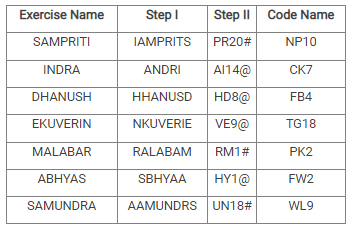
Note: In every step operation is performed on the output of the previous step.
What is output in step II for excise ‘VAJRA PRAHAR’?


